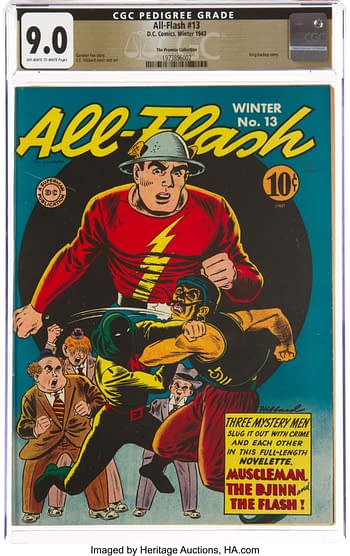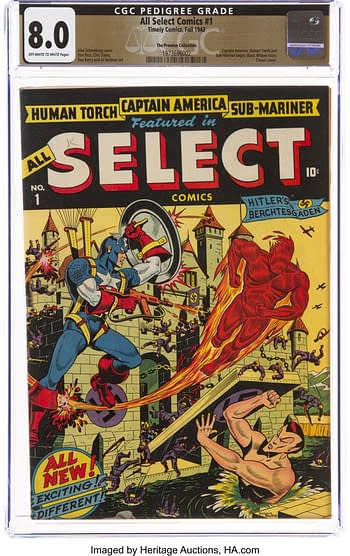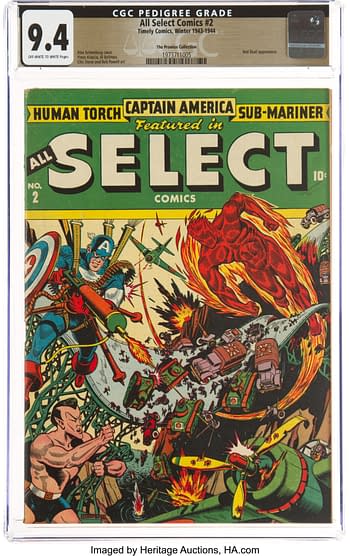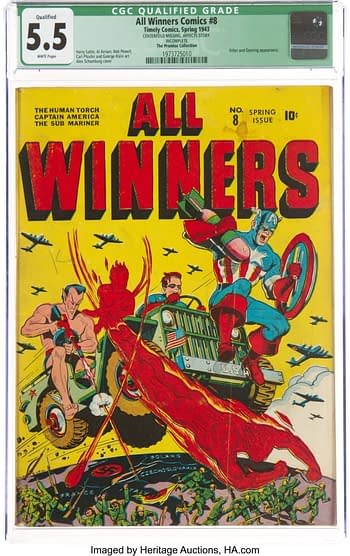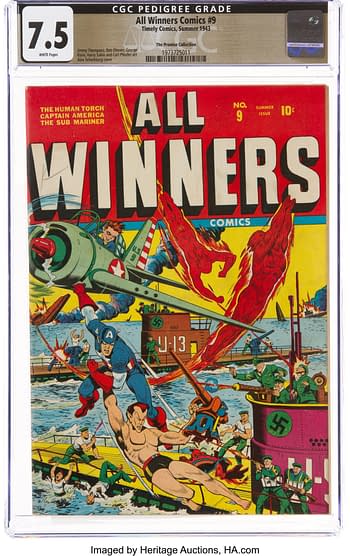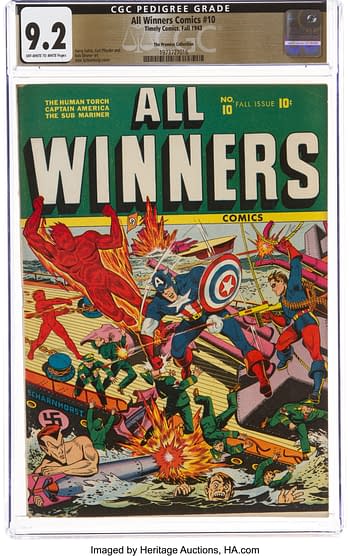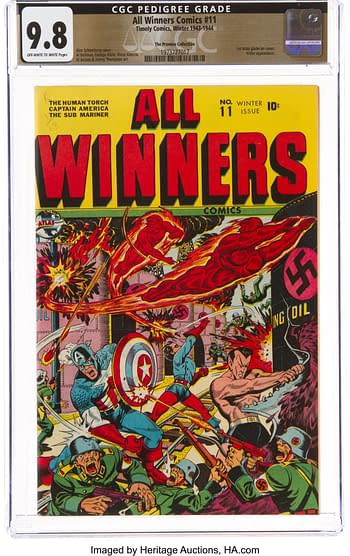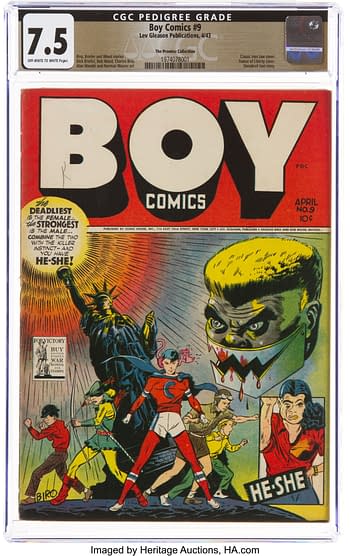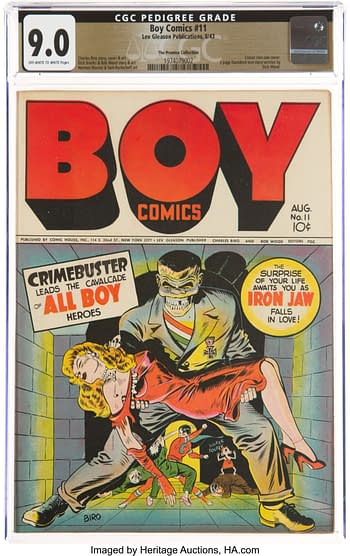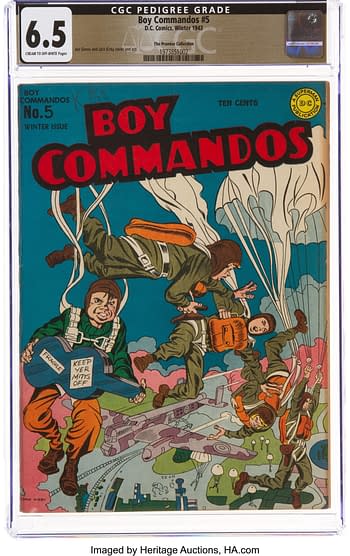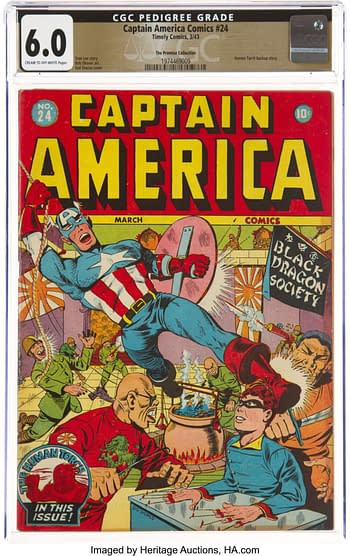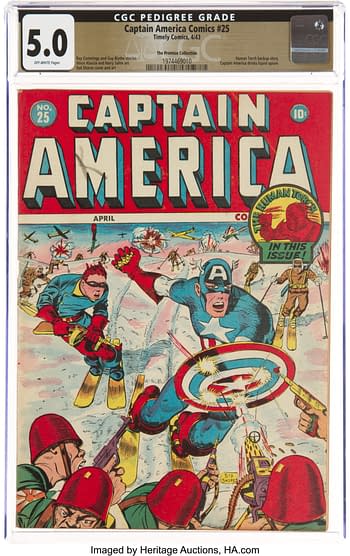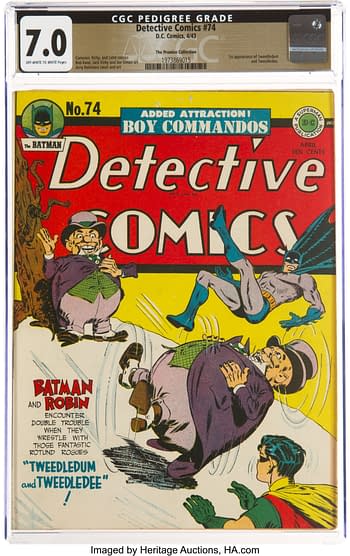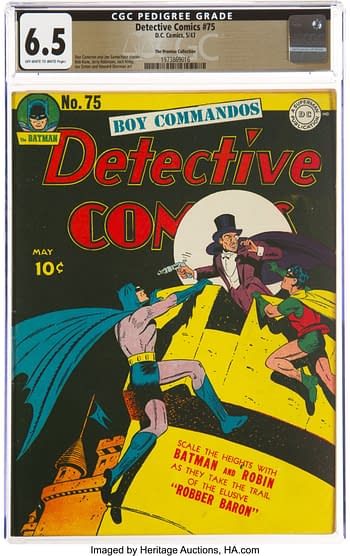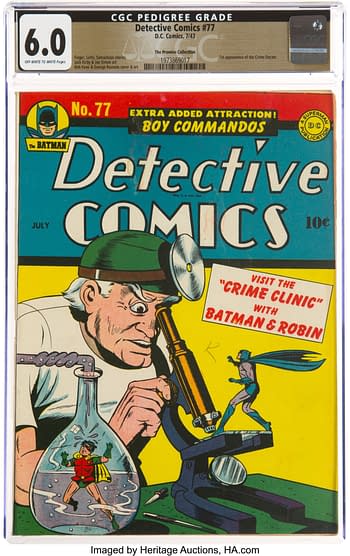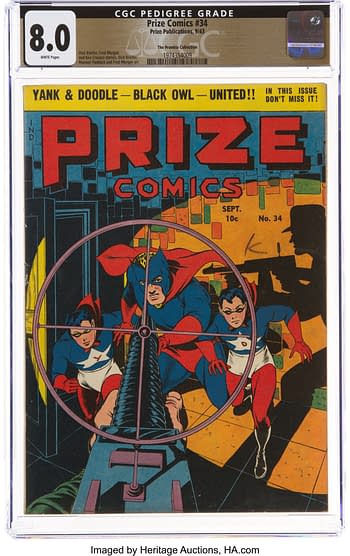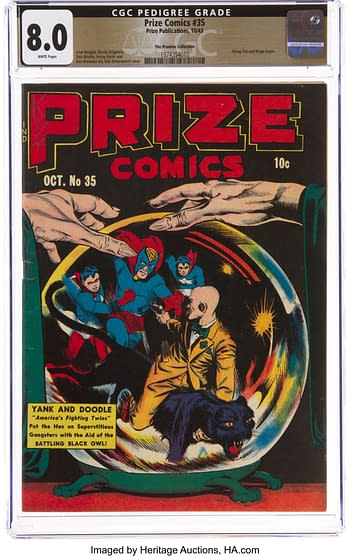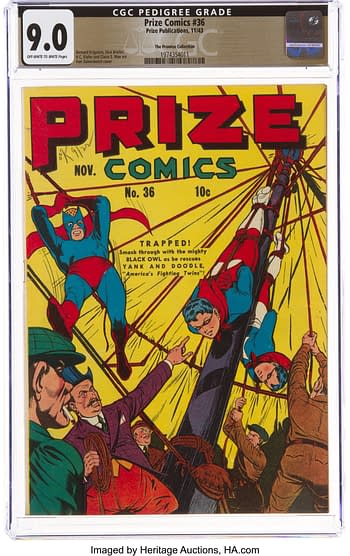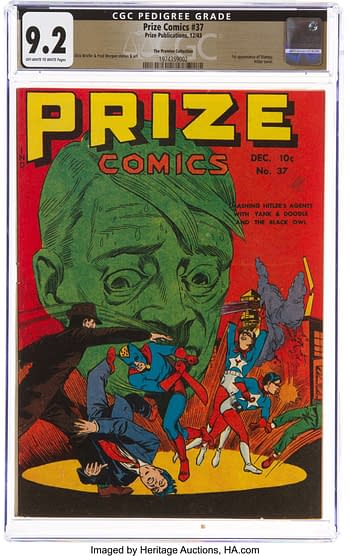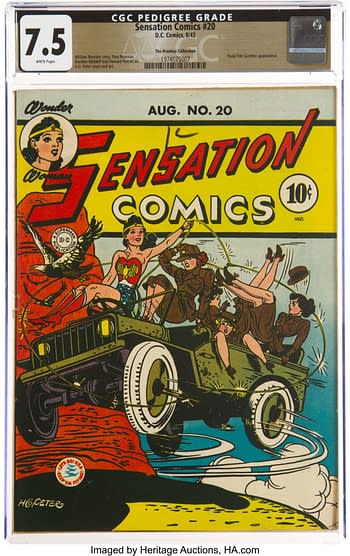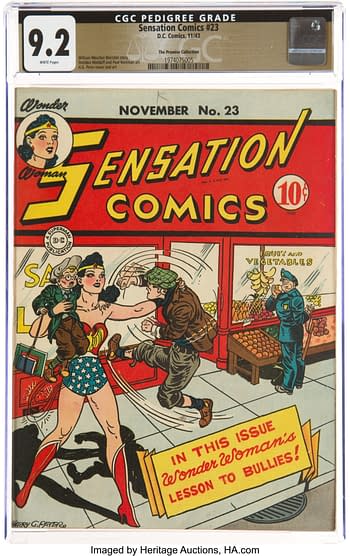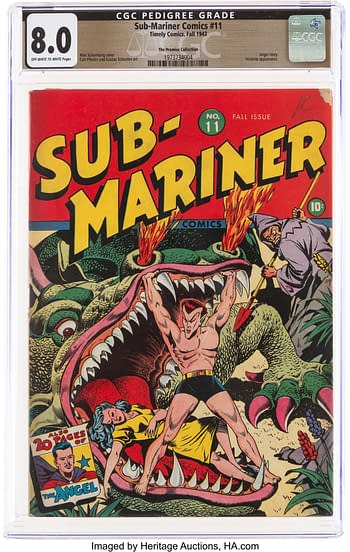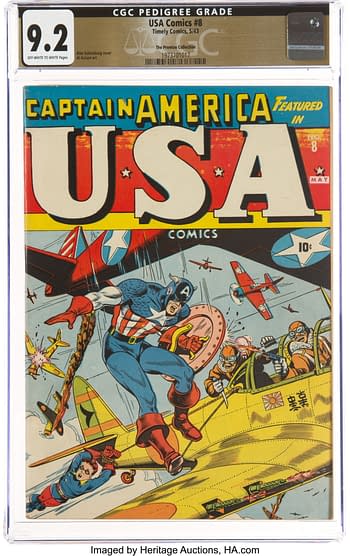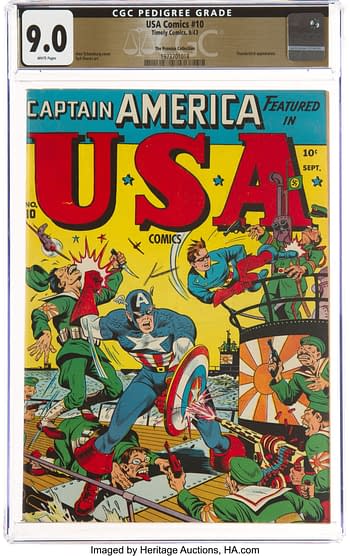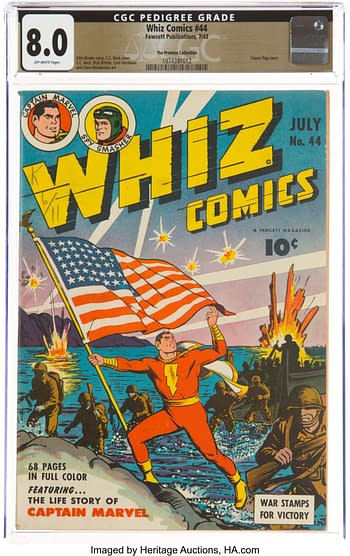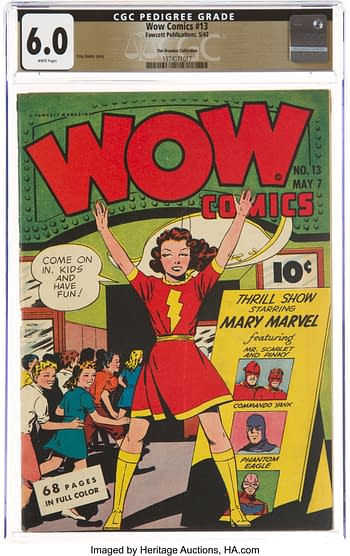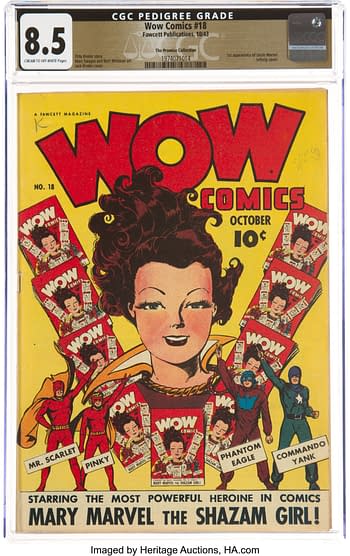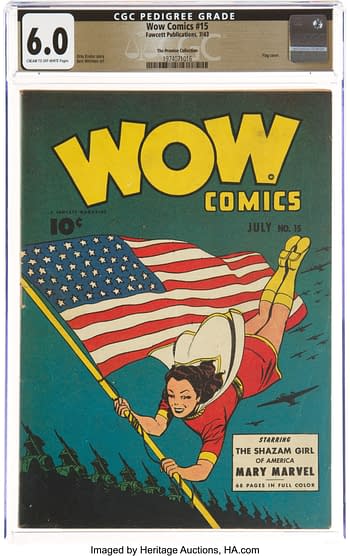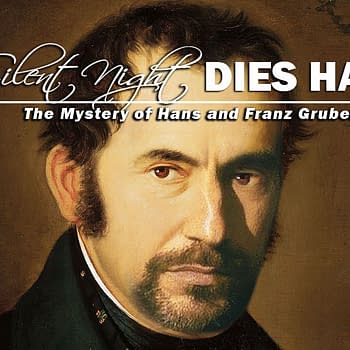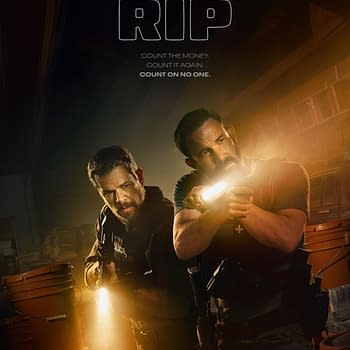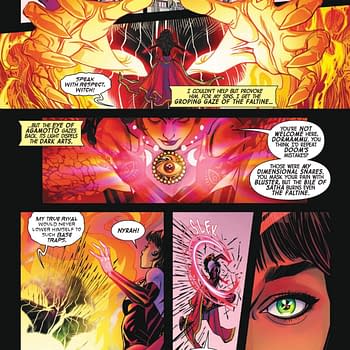Posted in: Comics, Vintage Paper | Tagged: captain america, Promise Collection, wonder woman
The Promise Collection 1943: Wonder Woman for President
"I am 12 years old, in the seventh grade, and collect comic books," says a two-sentence item in the Chicago Tribune of March 1943, from a young comic book collector named Larry who was having so much trouble finding a certain comic book that he had written a letter to the editor of the newspaper seeking help. "I will trade (all in good condition) one April All-American Comics, one April Super Comics featuring Dick Tracy, and one old Captain Marvel Jr. Master Comics for one copy of Superman in the White House by O.W.I." This unassuming little blurb appeared next to other letters to the editor that day such as one opinion on Wendell Willkie's chances as the Republican candidate for President the next year, and several points of view on the merits of current President Franklin Delano Roosevelt's New Deal. Neither 12-year-old Larry nor the Chicago Tribune's editors realized it at the time but seeking out that elusive Superman comic book tells us more about the state of 1943 American comic books — and America itself of that moment — than any of those other letters that day.
Welcome to Part 6 of the Promise Collection series, which is meant to serve as liner notes of sorts for the comic books in the collection. The Promise Collection is a set of nearly 5,000 comic books, 95% of which are blisteringly high grade, that were published from 1939 to 1952 and purchased by one young comic book fan. The name of the Promise Collection was inspired by the reason that it was saved and kept in such amazing condition since that time. An avid comic book fan named Junie and his older brother Robert went to war in Korea. Robert Promised Junie that he would take care of his brother's beloved comic book collection should anything happen to him. Junie was killed during the Korean War, and Robert kept his promise. There are more details about that background in a previous post regarding this incredible collection of comic books. And over the course of a few dozen articles in this new series of posts, we will also be revealing the complete listing of the collection. You can always catch up with posts about this collection at this link, which will become a hub of sorts regarding these comic books over time.
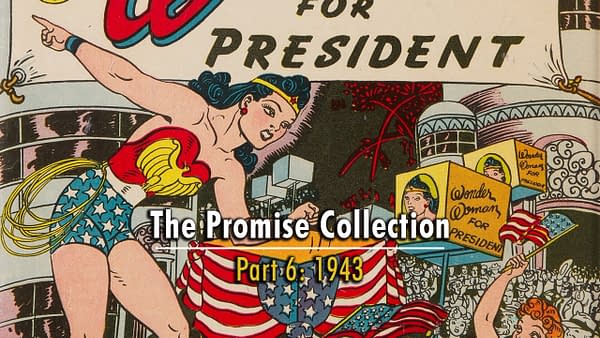
April through December 1943 in the Promise Collection
One of the things that makes the Promise Collection so impressive is to consider how much more difficult serious collecting on par with what Junie was doing 1939-1952 would have been compared to what collecting has become today. Imagine having to resort to writing a letter to the editor in a desperate attempt to find a comic book you need, instead of watching for it on an auction site. Consider the near-impossibility of the blistering high grades of the Promise Collection comics without the benefit of modern preservation materials. Larry, that avid comic book collector who wrote a letter to the Chicago Tribune in 1943 might have been a little like Junie. Both were around 12 years old in 1943, they read some of the same comics at the time, and it's clear they were both very serious about comic book collecting. For the record, they are not the same person, but of course, comic book collecting had become a thing by that time. There were comic strip gags about it, book anecdotes referencing it, and even a comic book series devoted to the boy with the most comic books in America. And as a collector myself, I can't help but wonder if how long Larry searched for that Superman comic book that he wanted so badly that offered to trade three-for-one for it before he realized he wasn't exactly looking for a Superman comic book at all.
"Superman in the White House by O.W.I." is, in reality, The Life of Franklin D. Roosevelt, a comic book published by the Office of Wartime Information — an organization we discussed extensively in Part 5 of this Promise Collection series for its close relationship with the major comic book publishers of the era. But Larry in Chicago thought that The Life of Franklin D. Roosevelt was a Superman comic book because Congressman John Tabor had compared it to one on the floor of the House of Representatives. Tabor and others were concerned that the comic book was partisan propaganda in support of FDR's then-upcoming bid for an unprecedented fourth term. It's pretty difficult to deny that it's exactly that, though I personally prefer Jon L. Blummer's crafty representation of FDR as the Ultra-Man in All-American Comics. Congressman Tabor's concerns would not be the last that were heard about government-sponsored or purchased reading matter ahead of the 1944 election, even in regards to comic books and pulps. Nor would it be the last comic book published about the upcoming Presidential election this year.
The business of comic books was under more pressure and scrutiny than ever in 1943. Paper availability had tightened up dramatically by Spring that year. Critics were trying to ban comic books across the country. The FBI's Gerald Norris blamed acts of sabotage in war plants on comic books. A Superman comic strip early this year "touched off a flurry of activity" in the Roosevelt Administration. But the comic book industry was able to deflect most criticisms in 1943 due to one simple development: soldiers loved comic books. As one July 1943 magazine article succinctly put the situation, "Paper producers have objected to using paper for comic books. Efforts to curtail them, however, run into serious opposition. These comic books, it appears are vastly popular and heavily in demand among the nation's soldiers and sailors."
This is not to say that the comic book industry was immune to paper shortages. The first DC Comics release to drop from 64 to 56 pages (not including covers) in the Promise Collection was Batman #17, cover-dated June-July 1943. Marvel made the move at around the same time, with All-Winners Comics #9 the first 56 pager from the publisher in the collection, cover-dated Summer 1943. Interestingly, while many other publishers had made the move to 56 pages by the end of 1943, others like Hillman Publications held the line on page count through early 1944, or employed other strategies. Fawcett held its flagship Whiz Comics at 64 pages through January 1944 (cover-dated) but dropped Wow Comics to 56 pages and Captain Marvel Jr. all the way down to 48 pages at the same time. Publishers combined these moves with various combinations of reducing the width of their comic books to further conserve paper usage. There are also significantly fewer #1 issues from this April to December 1943 period than had been in the previous months, with Plastic Man #1 and All Select Comics #1 being among the notable exceptions. But numerous titles appear in the collection for the first time in this period, such as Hit Comics, USA Comics, Military Comics, Prize Comics, Rangers Comics, Sub-Mariner Comics and others.
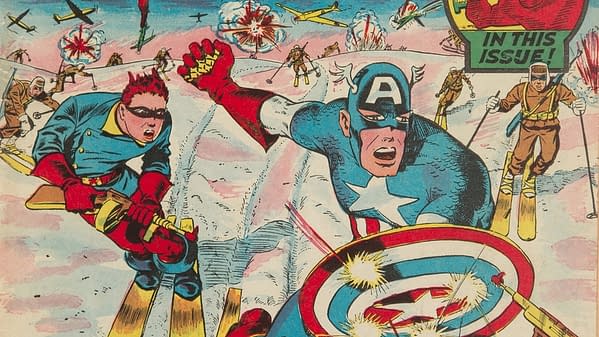
Princess of the Atom
The relative lack of series debut issues over this period does not mean that this period of the collection is lacking in key issues — quite the contrary. Batman #16 featuring the first appearance of Alfred is present in the Promise Collection, with a delightfully humorous story that includes a very subtle war tie-in. Air Fighters Volume 2 #2 featuring the first appearance of Valkyrie is another classic issue of the era. Even Military Comics #20 which debuts a character that is essentially the Golden Age version of Lady Blackhawk is an underappreciated key.
But Captain America Comics #25 and #26 might just be among the most underappreciated keys of the entire Golden Age. These issues debut a concept which Marvel now calls the Quantum Realm, which is an aspect of the classic Marvel Multiverse concept that has become an important factor in the Marvel Cinematic Universe. Referred to as the Microverse in the comics, the origins of the Quantum Realm idea reach back to these two issues of Captain America Comics — and beyond. A century before Avengers: Endgame, brought the quantum realm into the fabric of one of the highest-grossing films of all time, pulp science fiction author Ray Cummings would start developing the concept of what we now call the Quantum Realm in the Girl in the Golden Atom story from the pulp All-Story Magazine, March 15, 1919.
Cummings himself adapted his 1929 follow-up to Girl in the Golden Atom, called Princess of the Atom for Marvel/Timely in a two-part story of the same name in Captain America Comics #25 and 26. One can make a pretty convincing argument that Princess of the Atom is Marvel's first Microverse story, which makes it the comic book key to the Quantum Realm concepts that are so important to the MCU today. Cummings, who had worked for Thomas Edison as a technical writer, was one of the most influential science fiction authors of the pulp era. So influential, in fact, that other authors built on his concepts.
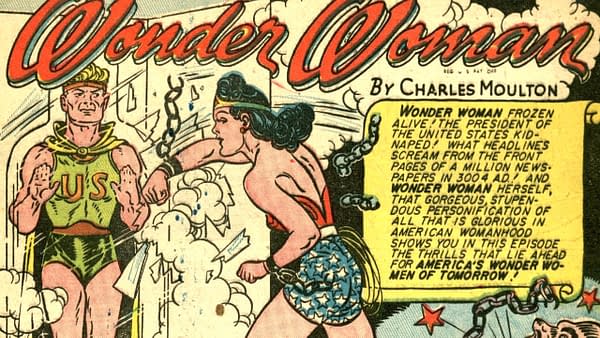
The Princess President
Wonder Woman #7 is every bit as historically fascinating as Captain America Comics #25 and #26, in a way that involves an intricately woven combination of the science and politics of 1943. The extent to which this issue is pulled from the headlines of the day is suggested in a simple but important way at the outset of the story. The title page caption blurb explains: "How would you like to gaze into the magic sphere of Paradise Island and see the future world as it will be 1,000 years from now with you playing a leading part in its history? That was Wonder Woman's experience and it brought care and trouble as well as new thrills and dangerous adventure into her glamourous life! When Etta Candy discovered the life vitamin that renews youth she little dreamed that this priceless gift to humankind would endanger the life of a beautiful girl president of the United States, far off in the future — but let the magic sphere tell its own story. Beautiful as Aphrodite, wise as Athena, stronger than Hercules, swifter than Mercury, Wonder Woman links Paradise Island with beloved America, the country for which she gave up her birthright to serve in its time of need. Out of an ageless past Wonder Woman brings to you a future of thrills and beauty in The Adventure of the Life Vitamin."
The "Life Vitamin" is real, and it made headlines around the country in early 1943. As explained in this Associated Press story from May 18, 1943, the "Life Vitamin" is Biotin, then created in synthetic form for the first time, according to this report. A member of the family of B vitamins, Biotin is marketed to this day as a supplement that acts as a metabolism booster and helps skin and hair maintain a more youthful appearance — although the scientific consensus on the matter is now much more conservative. But this so-called "Life Vitamin" acts as a framework for Aphrodite to show Wonder Woman a future where humans enjoy very long lives — and women have become ascendant in politics.
Many of the political elements of the 1940s and the 1944 election cycle, in particular, are strongly suggested in the story in Wonder Woman #7. As we saw with the "Life Vitamin" framework, the ripped-from-the-headlines elements are made clear beginning in the first arc of the story. In the United States of 3000 AD, where humans are capable of living for thousands of years, women have risen to power in national politics. This future story opens with a female President in power and a political villain with the obvious name of "Grafton Patronage" having recently been defeated and imprisoned. It's likely no coincidence that in 1943, the League of Women Voters had chosen to focus on political patronage that year, just as it was a topic of national discussion.
This plot element leads to the likely introduction of one of the most important political players of the era into the storyline: Presidential candidate Thomas Dewey. A character called the "Commissioner of the United States Police" is called upon for his expertise regarding convicted criminal Grafton Patronage. This character strongly resembles Dewey, who during his tenure as New York City prosecutor, District Attorney of New York County, and briefly United States Attorney for the Southern District of New York, rose to become one of the most famous law enforcers in the country for taking on the likes of Lucky Luciano and Dutch Schultz. President Franklin Delano Roosevelt's politics are clearly represented by a minor plot point which mentions that "New Era law forbidding manufacture of arms is being of arms is being defied! Exterminator rifles and handguns are being made and sold secretly to men!" This "New Era" gun control is a straightforward reference to FDR's "New Deal for Crime", and a bill known as the National Firearms Act of 1934. With gangsters like Pretty Boy Floyd and Machine Gun Kelly making national headlines, the law sought to more closely regulate the sale of certain types of firearms.
The story's use of a new political party, the Man's World Party, is perhaps its most interesting political element. The characters and plot points in play make it likely that this party was inspired by a new political party in 1943 who also fielded a candidate for President of the United States the next year. The America First Party of 1943, an isolationist party whose members split from the Republican Party and whose founder, Gerald L.K. Smith, was also associated with white supremacy. Smith was also a member of the blatantly pro-Nazi organization, the Silver Shirts, or Silver Legion of America. The founder of the Man's World Party in the Wonder Woman #7 story is a dead ringer for America First Party (1943) founder Gerald L.K. Smith, while that character's background and methods seem inspired by the bizarre background of Smith's associate, Silver Shirts founder William Dudley Pelley. In the comic book story, the Man's World Party's "Purple Shirts" appears to be an obvious reference to Pelley's Silver Shirts.
Wonder Woman's potential readership among US Soldiers would be severely curtailed just a few months later for unrelated political reasons. The beginning of 1944 would see the passage of Title V of the 1944 Soldier Voting Act, which was designed to prevent the type of partisan influence that Congressman Tabor complained about with The Life of Franklin D. Roosevelt and its superheroic representation of one party's candidate. By early 1944, the U.S. Army was "furnishing free of charge 4,000,000 copies each month" of numerous magazines to soldiers, and now the War Department had compiled a list of 189 magazines that could be purchased by the military in compliance with the new voting law and without additional scrutiny for political content. Sensation Comics was on the list, Wonder Woman was not (curiously, for some but not all publishers, the list seems to prefer anthologies over character-focused titles, which seems counter-intuitive to what we know about likely demand during this period). This aside, there are quite a lot of comics and pulps on that list, which would seem to indicate that Congress had forgotten what it learned about the persuasive power of comic books earlier that year. It's a lesson they would learn again in times to come.
| Title | haIss | CGC Grade / Auction Links | Publication Date | Prices Realized |
|---|---|---|---|---|
| Air Fighters Comics | v1 8 | May 1943 | ||
| Air Fighters Comics | v1 12 | September 1943 | ||
| Air Fighters Comics | v2 1 | October 1943 | ||
| Air Fighters Comics | v2 2 | November 1943 | ||
| Air Fighters Comics | v2 3 | December 1943 | ||
| All Select Comics | 1 | All Select Comics #1 (Timely, 1943) CGC VF 8.0 Off-white to white pages | Fall 1943 | $43,200.00 |
| All Select Comics | 2 | All Select Comics #2 (Timely, 1943) CGC NM 9.4 Off-white to white pages | Winter 1943-1944 | $43,200.00 |
| All-Flash | 11 | July-August 1943 | ||
| All-Flash | 12 | Fall 1943 | ||
| All-Flash | 13 | All-Flash #13 (DC, 1943) CGC VF/NM 9.0 Off-white to white pages | Winter 1943 | |
| All-Winners Comics | 9 | All Winners Comics #9 (Timely, 1943) CGC VF- 7.5 White pages | Summer 1943 | $10,800.00 |
| All-Winners Comics | 10 | All Winners Comics #10 (Timely, 1943) CGC NM- 9.2 Off-white to white pages | Fall 1943 | $28,800.00 |
| All-Winners Comics | 11 | All Winners Comics #11 (Timely, 1943) CGC NM/MT 9.8 Off-white to white pages | Winter 1943-1944 | $72,000.00 |
| America's Greatest Comics | 7 | Spring 1943 | ||
| America's Greatest Comics | 8 | Summer 1943 | ||
| Batman (1940) | 16 | April-May 1943 | ||
| Batman (1940) | 17 | June-July 1943 | ||
| Batman (1940) | 18 | August-September 1943 | ||
| Batman (1940) | 19 | October-November 1943 | ||
| Batman (1940) | 20 | December 1943-January 1944 | ||
| Big Chief Wahoo | 7 | Winter [1943] | ||
| Boy Comics | 9 | Boy Comics #9 (Lev Gleason, 1943) CGC VF- 7.5 Off-white to white pages | April 1943 | |
| Boy Comics | 10 | Boy Comics #11 (Lev Gleason, 1943) CGC VF/NM 9.0 Off-white to white pages | June 1943 | |
| Boy Comics | 11 | August 1943 | ||
| Boy Comics | 12 | October 1943 | ||
| Boy Comics | 13 | Boy Comics #13 CGC VF/NM 9.0 Off-white to white pages | December 1943 | |
| Boy Commandos | 2 | Spring 1943 | ||
| Boy Commandos | 3 | Summer 1943 | ||
| Boy Commandos | 4 | Boy Commandos #4 (DC, 1943) CGC FN 6.0 Off-white pages | Fall 1943 | $384.00 |
| Boy Commandos | 5 | Boy Commandos #5 (DC, 1943) CGC FN+ 6.5 Cream to off-white pages | Winter 1943 | $576.00 |
| Captain America Comics | 25 | Captain America Comics #25 (Timely, 1943) CGC VG/FN 5.0 Off-white pages | April 1943 | |
| Captain America Comics | 26 | May 1943 | ||
| Captain America Comics | 27 | June 1943 | ||
| Captain America Comics | 28 | July 1943 | ||
| Captain America Comics | 29 | August 1943 | ||
| Captain America Comics | 30 | September 1943 | ||
| Captain America Comics | 31 | October 1943 | ||
| Captain America Comics | 32 | November 1943 | ||
| Captain America Comics | 33 | December 1943 | ||
| Captain Marvel Jr. | 6 | April 21, 1943 | ||
| Captain Marvel Jr. | 7 | May 19, 1943 | ||
| Captain Marvel Jr. | 8 | June 1943 | ||
| Captain Marvel Jr. | 9 | July 1943 | ||
| Captain Marvel Jr. | 10 | August 1943 | ||
| Captain Marvel Jr. | 11 | September 1943 | ||
| Captain Marvel Jr. | 12 | October 1943 | ||
| Captain Marvel Jr. | 13 | November 1943 | ||
| Captain Marvel Jr. | 14 | December 1, 1943 | ||
| Captain Marvel Adventures | 23 | April 28, 1943 | ||
| Captain Marvel Adventures | 24 | June 1943 | ||
| Captain Marvel Adventures | 25 | July 1943 | ||
| Captain Marvel Adventures | 26 | August 1943 | ||
| Captain Marvel Adventures | 27 | September 1943 | ||
| Captain Marvel Adventures | 28 | October 1943 | ||
| Captain Marvel Adventures | 29 | November 1943 | ||
| Captain Marvel Adventures | 30 | December 1943 | ||
| Clue Comics | 4 | June 1943 | ||
| Clue Comics | 5 | September 1943 | ||
| Clue Comics | 6 | December 1943 | ||
| Comic Cavalcade | 2 | Spring 1943 | ||
| Comic Cavalcade | 3 | Summer 1943 | ||
| Comic Cavalcade | 4 | Fall 1943 | ||
| Comic Cavalcade | 5 | Winter 1943 | ||
| Daredevil Comics (1941) | 16 | April 1943 | ||
| Daredevil Comics (1941) | 17 | June 1943 | ||
| Daredevil Comics (1941) | 18 | August 1943 | ||
| Daredevil Comics (1941) | 19 | October 1943 | ||
| Daredevil Comics (1941) | 20 | November 1943 | ||
| Detective Comics | 74 | Detective Comics #74 (DC, 1943) CGC FN/VF 7.0 Off-white to white pages | April 1943 | $4,560.00 |
| Detective Comics | 75 | Detective Comics #75 (DC, 1943) CGC FN+ 6.5 Off-white to white pages | May 1943 | $2,160.00 |
| Detective Comics | 76 | Detective Comics #76 (DC, 1943) CGC VF 8.0 Off-white to white pages | June 1943 | $10,800.00 |
| Detective Comics | 77 | Detective Comics #77 (DC, 1943) CGC FN 6.0 Off-white to white pages | July 1943 | $2,280.00 |
| Detective Comics | 78 | Detective Comics #78 CGC VF+ 8.5 Off-white to white pages | August 1943 | |
| Detective Comics | 79 | September 1943 | ||
| Detective Comics | 80 | Detective Comics #80 (DC, 1943) CGC VF/NM 9.0 Off-white pages | October 1943 | |
| Detective Comics | 81 | Detective Comics #81 (DC, 1943) CGC VG/FN 5.0 Off-white pages | November 1943 | $1,380.00 |
| Detective Comics | 82 | December 1943 | ||
| Hit Comics | 27 | April 1943 | ||
| Hit Comics | 29 | September 1943 | ||
| Kid Komics | 2 | Summer 1943 | ||
| Kid Komics | 3 | Fall 1943 | ||
| Master Comics | 38 | May 5, 1943 | ||
| Master Comics | 39 | June 4, 1943 | ||
| Master Comics | 40 | July 1943 | ||
| Master Comics | 41 | August 1943 | ||
| Master Comics | 42 | September 1943 | ||
| Master Comics | 43 | October 1943 | ||
| Master Comics | 44 | November 1943 | ||
| Master Comics | 45 | December 1943 | ||
| Military Comics | 20 | July 1943 | ||
| Military Comics | 22 | September 1943 | ||
| Military Comics | 23 | October 1943 | ||
| Military Comics | 24 | November 1943 | ||
| Miss Fury | 3 | Winter 1943 | ||
| Plastic Man | 1 | Plastic Man #nn (#1) (Quality, 1943) CGC VF- 7.5 Off-white to white pages | 1943 | |
| Police Comics | 21 | August 1943 | ||
| Police Comics | 22 | September 1943 | ||
| Police Comics | 23 | October 1943 | ||
| Police Comics | 24 | November 1943 | ||
| Police Comics | 25 | December 1943 | ||
| Prize Comics | 32 | July 1943 | ||
| Prize Comics | 33 | August 1943 | ||
| Prize Comics | 34 | Prize Comics #34 (Prize, 1943) CGC VF 8.0 White pages | September 1943 | |
| Prize Comics | 35 | Prize Comics #35 (Prize, 1943) CGC VF 8.0 White pages | October 1943 | |
| Prize Comics | 36 | Prize Comics #36 (Prize, 1943) CGC VF/NM 9.0 Off-white to white pages | November 1943 | |
| Prize Comics | 37 | Prize Comics #37 (Prize, 1943) CGC NM- 9.2 Off-white to white pages | December 1943 | |
| Rangers Comics | 12 | August 1943 | ||
| Rangers Comics | 13 | October 1943 | ||
| Rangers Comics | 14 | December 1943 | ||
| Sensation Comics | 20 | Sensation Comics #20 (DC, 1943) CGC VF- 7.5 White pages | August 1943 | |
| Sensation Comics | 22 | Sensation Comics #22 (DC, 1943) CGC VF/NM 9.0 Off-white to white pages | October 1943 | |
| Sensation Comics | 23 | Sensation Comics #23 (DC, 1943) CGC NM- 9.2 White pages | November 1943 | |
| Sub-Mariner Comics | 10 | Sub-Mariner Comics #10 (Timely, 1943) CGC NM+ 9.6 White pages | Summer 1943 | $28,800.00 |
| Sub-Mariner Comics | 11 | Sub-Mariner Comics #11 (Timely, 1943) CGC VF 8.0 Off-white to white pages | Fall 1943 | $19,200.00 |
| Superman (1939) | 25 | November-December 1943 | ||
| USA Comics | 8 | USA Comics #8 (Timely, 1943) CGC NM- 9.2 Off-white to white pages | May 1943 | $36,000.00 |
| USA Comics | 10 | USA Comics #10 (Timely, 1943) CGC VF/NM 9.0 White pages | September 1943 | $21,000.00 |
| Whiz Comics | 41 | April 7, 1943 | ||
| Whiz Comics | 42 | May 7, 1943 | ||
| Whiz Comics | 43 | June 1943 | ||
| Whiz Comics | 44 | Whiz Comics #44 (Fawcett Publications, 1943) CGC VF 8.0 Off-white pages | July 1943 | $1,740.00 |
| Whiz Comics | 45 | August 1943 | ||
| Whiz Comics | 46 | September 1943 | ||
| Whiz Comics | 47 | October 1943 | ||
| Whiz Comics | 48 | November 1943 | ||
| Whiz Comics | 49 | December 1943 | ||
| Wonder Woman (1942) | 4 | April-May 1943 | ||
| Wonder Woman (1942) | 5 | June-July 1943 | ||
| Wonder Woman (1942) | 6 | Fall 1943 | ||
| Wonder Woman (1942) | 7 | Winter 1943 | ||
| World's Finest Comics | 9 | Spring 1943 | ||
| World's Finest Comics | 10 | Summer 1943 | ||
| World's Finest Comics | 11 | Fall 1943 | ||
| World's Finest Comics | 12 | Winter 1943 | ||
| Wow Comics | 13 | Wow Comics #13 (Fawcett Publications, 1943) CGC FN 6.0 White pages | May 7, 1943 | $552.00 |
| Wow Comics | 15 | Wow Comics #15 (Fawcett Publications, 1943) CGC FN 6.0 Cream to off-white pages | July 1943 | $660.00 |
| Wow Comics | 17 | Wow Comics #17 (Fawcett Publications, 1943) CGC VF 8.0 Cream to off-white pages | September 1943 | |
| Wow Comics | 18 | Wow Comics #18 (Fawcett Publications, 1943) CGC VF+ 8.5 Cream to off-white pages | October 1943 | $1,080.00 |
| Wow Comics | 19 | November 1943 | ||
| Wow Comics | 20 | December 1943 | ||
| Young Allies | 7 | April 1943 | ||
| Young Allies | 8 | July 1943 | ||
| Young Allies | 9 | Fall 1943 | ||
| Young Allies | 10 | Winter 1943-44 |
- All-Flash #13 The Promise Collection Pedigree (DC, 1943) CGC VF/NM 9.0 Off-white to white pages
- All Select Comics #1 The Promise Collection Pedigree (Timely, 1943) CGC VF 8.0 Off-white to white pages.
- All Select Comics #2 The Promise Collection Pedigree (Timely, 1943) CGC NM 9.4 Off-white to white pages.
- All Winners Comics #8 The Promise Collection Pedigree (Timely, 1943) CGC Qualified FN- 5.5 White pages.
- All Winners Comics #9 The Promise Collection Pedigree (Timely, 1943) CGC VF- 7.5 White pages.
- All Winners Comics #10 The Promise Collection Pedigree (Timely, 1943) CGC NM- 9.2 Off-white to white pages.
- All Winners Comics #11 The Promise Collection Pedigree (Timely, 1943) CGC NM/MT 9.8 Off-white to white pages.
- Boy Comics #9 The Promise Collection Pedigree (Lev Gleason, 1943) CGC VF- 7.5 Off-white to white pages.
- Boy Comics #11 The Promise Collection Pedigree (Lev Gleason, 1943) CGC VF/NM 9.0 Off-white to white pages.
- Boy Comics #13 The Promise Collection Pedigree (Lev Gleason, 1943) CGC VF/NM 9.0 Off-white to white pages.
- Boy Commandos #4 The Promise Collection Pedigree (DC, 1943) CGC FN 6.0 Off-white pages.
- Boy Commandos #5 The Promise Collection Pedigree (DC, 1943) CGC FN+ 6.5 Cream to off-white pages.
- Captain America Comics #24 The Promise Collection Pedigree (Timely, 1943) CGC FN 6.0 Cream to off-white pages
- Captain America Comics #25 The Promise Collection Pedigree (Timely, 1943) CGC VG/FN 5.0 Off-white pages
- Detective Comics #74 The Promise Collection Pedigree (DC, 1943) CGC FN/VF 7.0 Off-white to white pages.
- Detective Comics #75 The Promise Collection Pedigree (DC, 1943) CGC FN+ 6.5 Off-white to white pages.
- Detective Comics #76 The Promise Collection Pedigree (DC, 1943) CGC VF 8.0 Off-white to white pages.
- Detective Comics #77 The Promise Collection Pedigree (DC, 1943) CGC FN 6.0 Off-white to white pages.
- Detective Comics #78 The Promise Collection Pedigree (DC, 1943) CGC VF+ 8.5 Off-white to white pages.
- Detective Comics #80 The Promise Collection Pedigree (DC, 1943) CGC VF/NM 9.0 Off-white pages.
- Detective Comics #81 The Promise Collection Pedigree (DC, 1943) CGC VG/FN 5.0 Off-white pages.
- Miss Fury #2 The Promise Collection Pedigree (Timely, 1943) CGC VF+ 8.5 White pages.
- Plastic Man #nn (#1) The Promise Collection Pedigree (Quality, 1943) CGC VF- 7.5 Off-white to white pages.
- Prize Comics #34 The Promise Collection Pedigree (Prize, 1943) CGC VF 8.0 White pages.
- Prize Comics #35 The Promise Collection Pedigree (Prize, 1943) CGC VF 8.0 White pages.
- Prize Comics #36 The Promise Collection Pedigree (Prize, 1943) CGC VF/NM 9.0 Off-white to white pages.
- Prize Comics #37 The Promise Collection Pedigree (Prize, 1943) CGC NM- 9.2 Off-white to white pages.
- Sensation Comics #20 The Promise Collection Pedigree (DC, 1943) CGC VF- 7.5 White pages.
- Sensation Comics #22 The Promise Collection Pedigree (DC, 1943) CGC VF/NM 9.0 Off-white to white pages.
- Sensation Comics #23 The Promise Collection Pedigree (DC, 1943) CGC NM- 9.2 White pages.
- Sub-Mariner Comics #10 The Promise Collection Pedigree (Timely, 1943) CGC NM+ 9.6 White pages.
- Sub-Mariner Comics #11 The Promise Collection Pedigree (Timely, 1943) CGC VF 8.0 Off-white to white pages.
- Sub-Mariner Comics #12 The Promise Collection Pedigree (Timely, 1943) CGC VF- 7.5 White pages.
- USA Comics #8 The Promise Collection Pedigree (Timely, 1943) CGC NM- 9.2 Off-white to white pages.
- USA Comics #10 The Promise Collection Pedigree (Timely, 1943) CGC VF/NM 9.0 White pages.
- Whiz Comics #44 The Promise Collection Pedigree (Fawcett Publications, 1943) CGC VF 8.0 Off-white pages.
- Wow Comics #13 The Promise Collection Pedigree (Fawcett Publications, 1943) CGC FN 6.0 White pages.
- Wow Comics #17 The Promise Collection Pedigree (Fawcett Publications, 1943) CGC VF 8.0 Cream to off-white pages.
- Wow Comics #18 The Promise Collection Pedigree (Fawcett Publications, 1943) CGC VF+ 8.5 Cream to off-white pages.
- Wow Comics #15 The Promise Collection Pedigree (Fawcett Publications, 1943) CGC FN 6.0 Cream to off-white pages.


